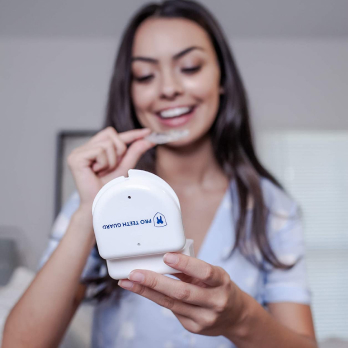NTI Night Guard
17th Jan 2020
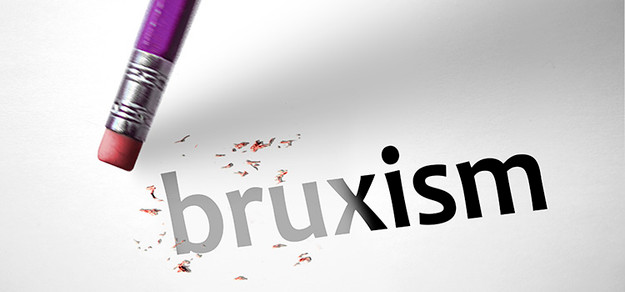
The American Academy of Oral Medicine explains that stress, sleep disorders, snoring, heavy alcohol consumption, smoking, and certain medications can cause a person to grind and clench their teeth. When it happens occasionally, it's generally not a problem. However, if grinding or clenching becomes a frequent, repetitive action, steps must be taken to protect the teeth. Persistent unconscious teeth grinding or teeth clenching is called bruxism. Whether it occurs when you're awake or when you're asleep, it endangers your oral health, aggravates the jaw's temporomandibular joint, and increases your risk of suffering from headache pain, ear and jaw pain, and sleep difficulties. Could investing in an NTI appliance (NTI night guard) help you manage your bruxism?
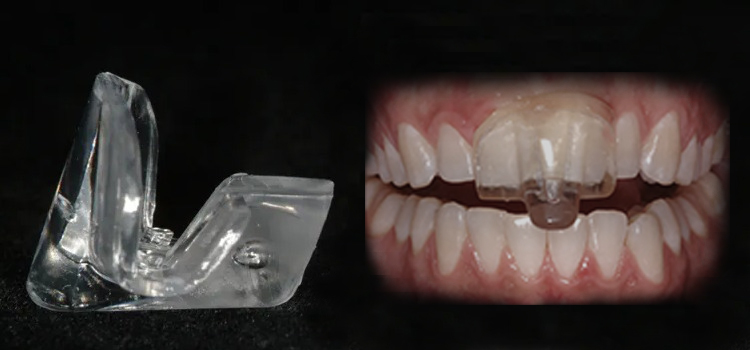
image: US National Library of Medicine National Institutes of Health
What Is the NTI Device (NTI night guard)?
The Nociceptive Trigeminal Inhibition Tension Suppression System, commonly referred to as the NTI-tss device, is approved by the FDA (U.S. Food and Drug Administration) for the prevention of bruxism, medically diagnosed migraines, and TMJ (temporomandibular joint disorder). The NTI-tss device is a small splint crafted from resin or acrylic. Unlike traditional mouth guards that cover all your teeth, the NTI device is worn over just the central incisors, or front teeth, while you sleep.
HOW DOES THE NTI DEVICE WORK?
In a study of the NTI device’s effectiveness, researchers discovered, “Evidence from randomized control trials suggests that the NTI-tss device may be successfully used for the management of bruxism and TMD” (2008). The NTI device fits over the front top incisors, which prevents them from touching the lower teeth. This relieves the muscle tension that so often causes painful symptoms of TMJ or bruxism. If you start to clench or gnash your teeth while wearing the device, you'll trigger the NTI reflex which will force your jaw to automatically relax, stopping any teeth grinding before it starts. Additionally, the NTI night guard also functions as a bite guard. When NTI dental mouth guard is in place, it creates a barrier which prevents you from bringing your teeth together and grinding. As with most forms of treatment, the NTI dental device has pros and cons. The best way to discover if it is right for you is having knowledge of the device, awareness of your symptoms, and open communication with an oral health expert.
Related Articles:
BENEFITS OF USING THE NTI NIGHT GUARD
For some dentists, the NTI mouthguard is the top choice for treating bruxism, migraines, and TMJ. While only the front teeth are actually covered by the device, its presence in the mouth keeps the jaw open and the back teeth separated. Popping it in can immediately reduce the wear and tear on the enamel of the canines and molars. Dr. Gordon Christensen of Dental Economics states,
"It has been my experience, after hearing comments of dentists on the lecture circuit and from our controlled research findings, that the concept of placing a small, discluding piece of resin in the anterior of the mouth - which disallows any other tooth contact- has been successful when compared to conventional occlusal splints" (2006).
The benefits of the NTI night guard are as follows:
- The NTI-tss is the smallest type of mouth guard available
Patients have reported their approval of the device because it is small and fits comfortably over only two teeth, as opposed to most other night guards which cover a row of teeth.
- It provides rapid relief
It is also beneficial because it triggers rapid relief. By providing a barrier between the teeth, the NTI device allows the jaw joint to rest and the muscles to relax, providing almost immediate relief from facial pain and headaches related to facial pain.
- It helps to break the habit of clenching/grinding
In addition, some experts believe that wearing the NTI dental appliance might work like behavior modification therapy. By constantly interrupting the user's unconscious efforts to bite down, the device trains the muscles to stop clenching. Over time, this could help break the habit of clenching the jaw.

CONCERNS WHEN USING THE NTI MOUTHGUARD
The NTI night guard offers immense relief for patients, but some dentists are hesitant to prescribe it to their patients. While the device sounds promising, there are questions about the NTI night guard's effectiveness, both long and short-term. Critics of the device point out that the NTI mouthguard comes with some unpleasant side effects and downsides:
- The NTI device can impact the user's bite.
Wearing the NTI night guard can cause the surrounding teeth to move, changing the patient's bite to what is known as an open bite. That is, the front top and bottom teeth protrude outward, and do not touch when the jaw is closed. The User’s Guide for the NTI Night Guard explains that the device “requires the mandible to pivot/rotate…, [which] may present as an anterior open bite. This is a rare development, and clinically can be observed to varying degrees in approximately 5% of those patients using the NTI-tss for pain relief and prevention” (2008). In other words, the NTI device can in fact alter the user’s bite; however, this has only been observed in a small portion of patients who have used the guard. An article published in 2017 explained, “open bite is considered one of the most challenging dentofacial deformities to treat” (Wajid et al., 2017). This malocclusion can cause the patient to develop TMJ side effects as well. For this reason, it is imperative that the NTI device be monitored by a dental health professional.
- Only patients with healthy teeth are candidates.
The NTI device is not suitable for everyone. Patients with damage to their front teeth, an unusual bite, or teeth that are loose, worn or weakened by advanced periodontal disease cannot use this device safely. Also, patients with degenerative arthritis or displaced disks in the jaw joint are not candidates for this device.
- It is a potential choking hazard
While the small size of the device is beneficial for comfort, it can be a potential choking hazard. The tongue can dislodge the device unknowingly during sleep. The Bruxism Association explains, “Information from an approved FDA database reveals that the size of the device is less than recommended by the Consumer Products Safety Commission Guidelines and as such could be a choking hazard”. While choking may be a concern, the literature shows that “one person in Norway and three individuals in the United States were subjected to medical emergencies due to aspirated NTI-tss devices”(Stapelmann and Türp 2008) so it is an extremely rare occurrence. It is vital that the NTI-tss fits snugly and firmly to your teeth so that it cannot become easily dislodged.
- A dentist's oversight is required for safe use.
Because using the NTI night guard can change a person's bite, the device must be fitted and monitored regularly by a dentist. Using it without proper oversight can make bruxism worse and harm the teeth. This requirement for regular professional oversight also adds to the cost of using an NTI night guard.
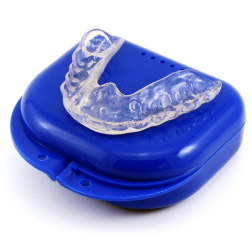
- Most Popular
- Hard Outside, Soft Inside
- 2MM Thick
- Moderate / Heavy
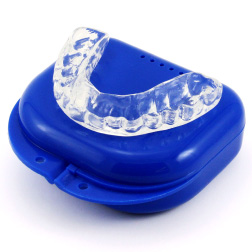
- Most Durable
- Hard Materials
- 1.5MM Thick
- Heavy / Severe
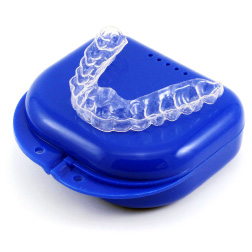
- For Day Time Use
- Thin, Barely Visible
- 1MM Thick
- Light / Moderate
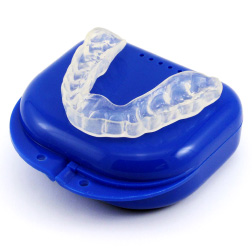
- For Clenching
- Flexible & Soft
- 1.5MM Thick
- Light / Moderate
WHAT ARE OTHER TREATMENT OPTIONS FOR BRUXISM?
Comparing the NTI night guard to other treatment options can help you make an informed decision. Since stress is a common trigger, many patients reduce their teeth grinding by incorporating stress-management techniques like exercise, massage, or meditation into their routine. Hypnosis for teeth grinding has also been used to manage bruxing by relieving stress.
Traditional mouthguards for teeth grinding are also an effective treatment to prevent wear and tear without altering your existing bite. These devices, also called occlusal guards or bite guards, are commonly used to treat bruxism and TMJ. They differ from the NTI night guard in that they fit over the entire arch rather than only the top front teeth. These guards can be custom-fitted for increased comfort and do not require as much oversight from your dentist, making them a cheaper treatment option.
The Bruxism Association notes that nearly 70% of bruxism may be the result of stress or anxiety
CONCLUSION
Bruxism hurts. If you believe that grinding your teeth may be behind your tension headaches, jaw pain, damaged teeth, or disturbed sleep, don't wait for things to get worse. Andrew Blumenfeld, a recognized researcher, says it best: “There is no treatment that will help everyone” (2011). Consult your dentist to make an informed decision about treatment and if NTI therapy is right for you.
Related Article:
Sources:
- Bruxism Association Writers. (n.d.). Causes Of Bruxism. The Bruxism Association. http://www.bruxism.org.uk/causes-of-bruxism.php
- Christense, Gordon (2006). Ask Dr. Christensen. Dental Economics. https://www.dentaleconomics.com/science-tech/article/16391340/ask-dr-christensen
- Dentaltown Magazine Writers. (2011). NTI-tss: Benefits, Concerns, Questions and Answers Drs. James Boyd and Andrew Blumenfeld. Dentaltown. https://www.dentaltown.com/magazine/article/3083/nti-tss-benefits-concerns-questions-and-answers
- Falace, D, et al. (2015). Tooth Clenching or Grinding. https://www.aaom.com/index.php?option=com_content&view=article&id=129:tooth-clenching-or-grinding&catid=22:patient-condition-information&Itemid=120
- NTI-TSS, Inc. Technical Services. (2008). Nociceptive Trigeminal Inhibition Tension Suppression System: User Guide. Retrieved fromhttp://www.chairsidesplint.com/docs/NTI_UsersGuide.pdf
- Stapelmann, H., & Türp, J. C. (2008). The NTI-tss device for the therapy of bruxism, temporomandibular disorders, and headache - where do we stand? A qualitative systematic review of the literature. BMC oral health, 8, 22. https://doi.org/10.1186/1472-6831-8-22
- Wajid MA, Chandra P, Kulshrestha R, Singh K, Rastogi R, et al. (2018). Open bite malocclusion: An overview. J Oral Health Craniofac Sci: 3: 011-020. DOI: 10.29328/journal.johcs.1001022
- Yap, A. U., & Chua, A. P. (2016). Sleep bruxism: Current knowledge and contemporary management. Journal of conservative dentistry: JCD, 19(5), 383–389. https://doi.org/10.4103/0972-0707.190007

- Most Popular
- Hard Outside, Soft Inside
- 2MM Thick
- Moderate / Heavy

- Most Durable
- Hard Materials
- 1.5MM Thick
- Heavy / Severe

- For Day Time Use
- Thin, Barely Visible
- 1MM Thick
- Light / Moderate

- For Clenching
- Flexible & Soft
- 1.5MM Thick
- Light / Moderate

